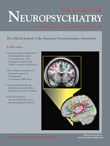Posttraumatic Parieto-Occipital Epilepsy
SIR: The prevalence of epilepsy after traumatic brain injury (TBI) is about 4%, 1 parietal and occipital seizures being considered a rare outcome. 2 , 3 We report a case of a patient where posttraumatic parieto-occipital seizures were misidentified as psychiatric symptoms, and stress the importance of the neuropsychological evaluation in the diagnosis, especially when imaging and electrophysiological exams show no anomalies.
Case Report
A 39-year-old right-handed woman, with no psychiatric history, suffered a TBI after being hit by a car, presenting a Glasgow Coma Scale score of 15 upon hospital admission. The cranial computed tomography scan revealed epidural left temporobasal hematoma and sinking left zygomatic arch fracture. More than a year after TBI, she started complaining of tingling and numbness in the right leg and inability to move despite no loss of power in the limb. These episodes lasted 1 to 2 minutes without loss of consciousness, but she had to interrupt ongoing tasks. They were preceded by a sense of malaise and followed by fatigue and disorientation, and their frequency had increased to an episode every 2 weeks. She also complained of poor concentration, forgetfulness, sleep disturbances, headache, dizziness, anxiety and sadness, and being medicated with antidepressants, without response. Magnetic ressonance imaging (MRI) 2 years after the accident and the EEG revealed no anomalies. During the neuropsychological evaluation, when drawing a three-dimensional figure (cube), she complained of difficulty in the task, dizziness and tingling of the right leg, followed by involuntary rapid tremor-like movements on the same side for about a minute, with no loss of consciousness. On the same day the EEG revealed paroxysmal bilateral temporo-occipital activity with left accentuation and contra-lateral homonymous propagation. The suggestion test was negative. She was medicated with a regimen of sodium valproate, 1600 mg daily, and reevaluated after 6 months, but when drawing a three-dimensional figure she developed a seizure with the same characteristics.
Comment
Our patient presented few risk factors for late seizures, 4 the first seizure occurring more than a year after TBI, similar to the 20 months’ mean time previously reported. 5 Parietal and occipital seizures are mainly characterized by the presenting auras, including somatosensory phenomena, although the clinical manifestations may spread beyond and overshadow the focal origin. The paresthesia may spread in a Jacksonian manner, with motor activity in the affected body member following the sensations in about 50% of cases. Some parietal seizures may resemble panic attacks and be misdiagnosed as a psychiatric disorder, but showing poor response to antidepressants, as with our patient. Parieto-occipital seizures may be provoked by stimuli involving the receptive, interpretive, and connective function of the parietal and occipital lobes. The EEG may show focal discharges in the posterior regions, but the seizures are often electrically silent. 3 Even though MRI and functional imaging often reveal underlying pathology, 3 a normal exam, as in our patient, should not exclude the presence of organic lesion. The constructional apraxia, revealed as a disturbance in drawing without correct spatial relationships, existed despite the absence of apraxia for single movements. 6 The copying deficit was particularly evident in drawing three-dimensional figures, and was not simply one of formulating the sequence of steps necessary to produce a complex abstract form. This may be due to a difficulty in encoding the pictorial structure of a model depicting a three-dimensional object, suggesting the existence of a parietooccipital lesion. In summary, although a rare outcome from TBI, posttraumatic parieto-occipital epilepsy may occur even after minor head trauma and few risk factors, and respond poorly to anticonvulsants. Symptom presentation is pleomorphic, and can be misdiagnosed as psychiatric. The neuropsychological evaluation is useful in the diagnosis, especially when functional and neuroimaging exams show no anomalies, and may help establishing a causative role for TBI in producing neuropsychiatric disorders, which is important from clinical, scientific, and legal perspectives.
1. Carvajal P, Almárcegui C, Pablo MJ, et al: Crisis parciales postraumáticas. Rev Neurol 2001; 33:737–739Google Scholar
2. Siegel AM, Williamson PD: Parietal lobe epilepsy. Adv Neurol 2000; 84:189–199Google Scholar
3. Sveinbjornsdottir S, Duncan JS: Parietal and occipital lobe epilepsy: a review. Epilepsia 1993; 34:493–521Google Scholar
4. Temkin NR: Risk factors for posttraumatic seizures in adults. Epilepsia 2003; 44:18–20Google Scholar
5. Salazar AM: Posttraumatic epilepsy: pathogenesis. Epilepsia 1998; 39:29–35Google Scholar
6. Marshall RS, Lazar RM, Binder JR, et al: Intrahemispheric localization of drawing dysfunction. Neuropsychologia 1994; 32:493–501Google Scholar



